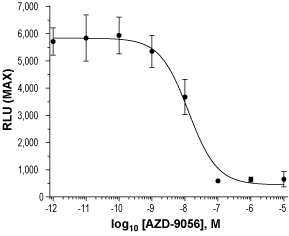Overview
- Seeland, S. et al. (2015) Pharmacol. Res. Perspect. 3, e00123.
- Hu, H. et al. (2016) Int. J. Mol. Med. 38, 1922.
 Alomone Labs AZD-9056 hydrochloride inhibits human P2X7 receptors expressed in HEK-293 cells.Dose-response curve of hP2X7 inhibition by AZD-9056 hydrochloride (#A-425). Cells were loaded with Fluo-8 NW dye, incubated with increasing concentrations of AZD-9056 hydrochloride, and stimulated with 80 µM BzATP. Changes in intracellular Ca2+ following agonist application were detected as changes in maximum relative fluorescence (RLU) using FLIPRTETRA™. IC50 was calculated at 12 nM.
Alomone Labs AZD-9056 hydrochloride inhibits human P2X7 receptors expressed in HEK-293 cells.Dose-response curve of hP2X7 inhibition by AZD-9056 hydrochloride (#A-425). Cells were loaded with Fluo-8 NW dye, incubated with increasing concentrations of AZD-9056 hydrochloride, and stimulated with 80 µM BzATP. Changes in intracellular Ca2+ following agonist application were detected as changes in maximum relative fluorescence (RLU) using FLIPRTETRA™. IC50 was calculated at 12 nM.
AZD-9056 hydrochloride is an adamantane amide that acts as a potent and selective antagonist of P2X7 receptors. It inhibits YoPro1 (membrane-impermeable fluorescent dye) uptake in HEK–hP2X7 cells with IC50 value of 11.2 nM1. Studies show that treatment with AZD-9056 exerts pain-relieving and anti-inflammatory effects1,2.
The P2X7 receptor is a member of the ligand-gated ion channels activated by extracellular ATP. There are seven receptor subtypes: P2X1–P2X7. P2X7 receptors participate in a variety of cellular responses such as membrane permeabilization, activation of caspases, cytokine release, cell proliferation, and apoptosis. P2X7 receptors are highly expressed throughout autonomic, sensory and central neurons and in visceral smooth muscle, immune cells and epithelia3,4.

